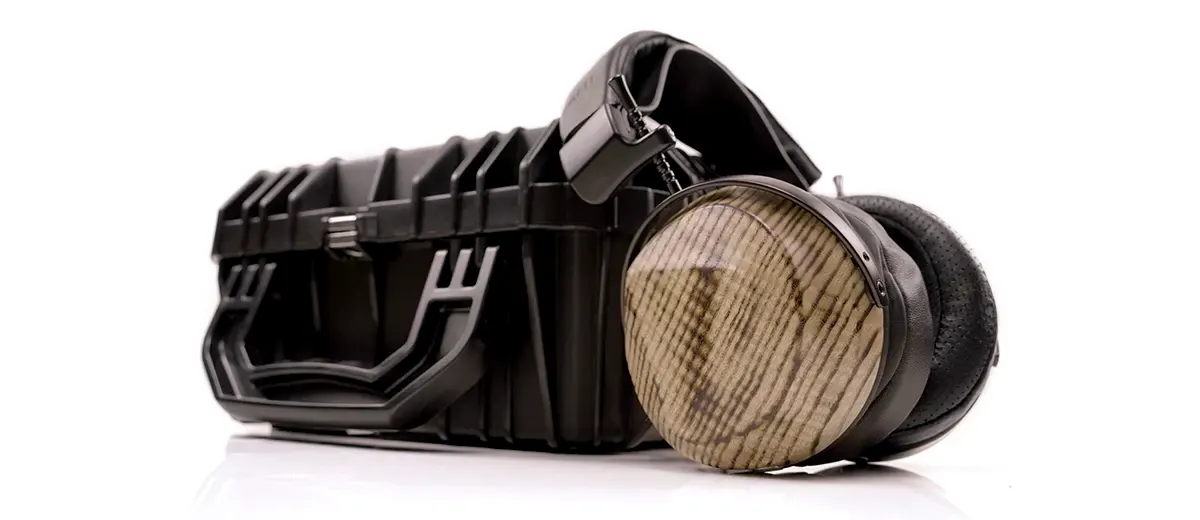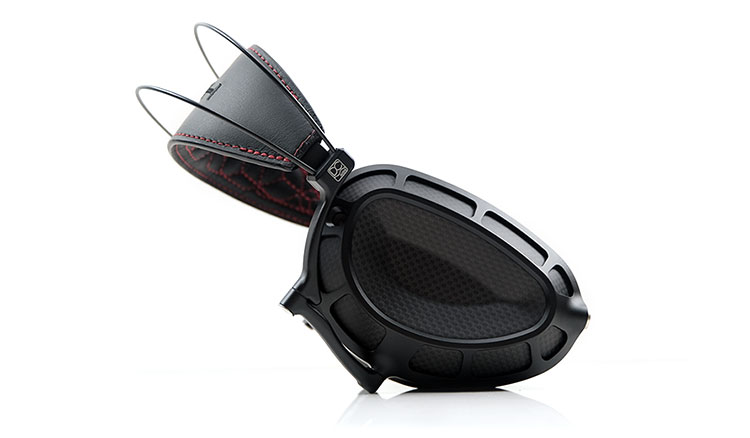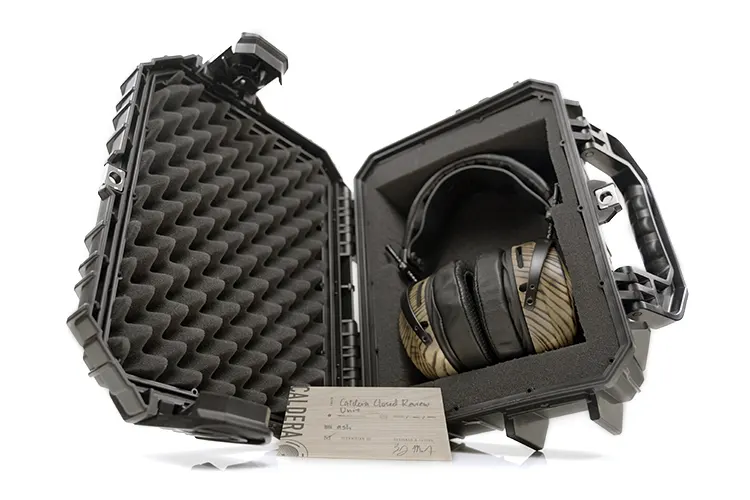Selected Comparisons
The following comparisons to the ZMF Headphones Caldera Closed were completed using a mix of ZMF’s Homage amplifier fed with a Shanling CA80 CDP as its source, a Cayin HA-300MK2/Holo Audio Spring 2 Wildism edition setup, and the dCS Bartok Apex.
ZMF Headphones Caldera Open
The ZMF Headphones Caldera Open was launched in late 2022, with our review just creeping in towards the end of that year. It was also our Top Gear Award 2022 winner for Best Open Headphones.
Technical
Both of these headphones share the same proprietary 80mm planar magnetic driver with gold-plated copper for its 4 traces and 8 pathway patterns. Both drivers also use the special silver coating to maximize excursion along the traces encased in a carbon fiber baffle.
They differ in their respective use of the Atrium damping system technology with the Closed-Back’s delivering stages of damping and diffusion rather than the Caldera Open’s centralized location to combat standing waves and give it a more natural staging quality within its vented close cup design.
Naturally, the two headphones have a similar level of efficiency since they share the same driver.
Both the Caldera Closed and Open versions have a medium impedance rating of 60Ω and a close SPL of 94-96 dB/mW (closed) compared to 96-97 dB/MW (open). This makes them workable from smaller desktop units with decent output but both will sound scale on more powerful amplifiers.
Design
The Caldera Closed’s headphone frame is unchanged from the Open sample I have. It’s more about the cup’s form factor and the differing choices of wood.
Arguably, the Caldera Closed’s Shou Sugi Ban ash wood finish is the more striking of the two headphones when compared to the Open sample we have here which is the stock American White Oak version.
The Caldera Open has more of a classic warmer wood finish aesthetic. It’s slightly darker, with a thinner more subdued grain as opposed to the dash of heavily saturated streaks on the Caldera Closed Cup.
Since it is an open back it also has a finely crafted black aluminum grill centerpiece which is a sharp contrast to the raised ‘Caldera Delta’ that contorts the cup form factor on the Caldera Closed a lot more.
The comfort levels will be largely dictated by the pads you use with each headphone. The stock Caldera Open pads have more perforation and are a bit thicker or taller which places your ear a little further away from the driver.
The Caldera Closed comes with either the new stock Hybrid or Caldera Thick pads and with what seems to be a more aggressive fluted finish creating the perception of a slightly wider opening.
Since both headphones have similar dimensions and weight the pressure dissipation is very similar. No prizes for guessing which headphone has the better passive isolation, the Caldera Closed.
Performance
On a technical basis, the Caldera Open performs on a higher level. Paired with everything from the Homage to the Bartok Apex it sounds more open with better layering and a more complex and immersive soundstage performance.
Vocal imaging is further forward on the Caldera Open with more immediacy to the mids compared to the Caldera Closed’s more neutral 1-3k range using the Hybrid pads. Switching to the Caldera Thick pads will open up the Caldera mids and give them some welcome additional energy and air.
The Caldera Closed Hybrid pads will sound a little more ‘sunken’ in their imaging, not quite as much left to right energy as the open version but does improve on weight and body, particularly on the mid-bass and lower-mids.
If you want to close the gap in the imaging and give the Caldera Closed a taller profile then I recommend using the Caldera Thick pads.
The Open version is more linear and neutral in its low-end so it does not carry the same weight or warmth. However, perception-wise it sounds tighter, seemingly faster on the excursion, and generally better for timing on punchier lows.
The Caldera Closed has a more languid sense of pace to it though instrumental weight and body are richer so if you want a more fulsome set of lows and do not mind a slight loss of pace then it will have an edge.
The neutral mids on the Caldera Closed combined with the slightly richer timbre will create a smoother vocal performance. Though not quite as clean and nuanced as the Caldera Open’s treatment of the same region it can sound more relaxing for longer listening sessions.
ZMF Headphones Atrium Closed
The ZMF Headphones Atrium Closed is the closed-back sibling to the Atrium Open version and was launched in mid-2023. We reviewed it in May 2023 and it went on to win a Top Gear 2023 Award for Best Closed headphones.
Technical
This is dynamic versus planar with two very different types of drivers inside the cups. The Atrium Closed uses a 50mm dynamic driver with a composite bio-cellulose diaphragm surrounded by N52 rare earth neodymium magnets and rated at 300Ω. This is a voltage-demanding headphone, much more so than the Caldera Closed’s 60Ω rating.
What is similar is the damping system modification from the open-back design to suit the closed-cup acoustical performance.
Both deploy the Atrium Damping System technology with gradual diffusion to eliminate the potential for standing sound waves and keep the sound as natural-sounding as possible for a closed-back.
There is no indication at the time of writing if the ADS in both is a duplicate but I suspect some minor tweaks were made to the Caldera Closed version to accommodate the planar driver.
Despite the different drivers the Caldera Closed and Atrium Closed have very close matching sensitivity ratings at 95dB/mW and 96dB/mW on paper.
However, testing from the ZMF Headphones Homage amplifier in a high gain setting the Atrium Closed came across as more sensitive to volume and gain increases. Paired with an OTL tube amp or good quality SETA alternative, the Atrium Closed will sound at its best given its high voltage requirements.
Design
There are several finished versions of the Atrium Closed from launch day last year and in ZMF’s current lineup for 2024.
The default is a natural Cherry finish which is the darker headphone cup on the right in the picture above. To the left is the Olivewood Limited Edition from Launch Day which is my preferred version for looks and performance.
The Limited Edition also comes with ZMF’s $59.99 B.B.B. strap in olive which is of higher quality than the stock strap on both the Caldera Closed and the Atrium Closed.
Preference is in the eye of the beholder regarding whether you prefer the Caldera Closed’s Shou Sugi Ban ash wood finish or the Olivewood Limited Edition.
I will say I prefer the ash of the Caldera Closed over the Atrium’s default natural cherry. It has a bit more pop and visual appeal with its striking grain finish.
The Atrium Closed Olivewood’s smoother cup might also be less topical visually compared to the Caldera Delta on the Caldera Closed cups form factor.
The Atrium Closed’s passive isolation performance is a little bit stronger compared to the Caldera Closed. There are a few reasons for that.
The first is the pads. Though similar in design with matching depth and a fluted finish, the Atrium Closed stock pads have a leather inner that is non-perforated compared to the more porous suede walls of the Caldera Hybrid pads.
The second is the more aggressive cup venting on the Caldera Closed which gives it an almost semi-open quality whereas the Atrium Closed venting is much smaller.
Other than that, there is not a big difference in pressure dissipation but perhaps due to the different pads, I find the Caldera Closed a little more comfortable to wear.
Performance
For this comparison, I went with my preferred Olivewood Edition of the Atrium Closed. The TLDR goes a bit like this; if the Caldera Open is on one end of the scale and the Atrium Closed on the other then the Caldera Closed sits somewhere in between.
Courtesy of its planar driver, the low end of the Caldera Closed has a more linear bass extension than the bloom and heightened sub-bass presence of the Atrium Closed’s dynamic driver.
The AC has more typical closed-back traits with its narrower soundstage and enhanced bloom but that dynamic driver is bombastic and fun sounding, more so than the Caldera Closed.
What the Caldera Closed does better is give you more space, a tighter low-end, and better note definition and resolution to go along with it. It is every bit as extended on the lows as the AC, just sounds more refined and not as dominant, especially on the upper-bass where the Olivewood AC has a heightened presence.
The Caldera Closed mids are slightly north of neutral from 500Hz up to 2k but do not carry the same level of warmth as the Atrium Closed courtesy of a stronger treble presence.
It will sound more forward for vocals but importantly, more open and airy sounding throughout the mids with better imaging and staging depth compared to the Atrium Closed in the same range. Higher-pitching percussion presence is also somewhat diminished in comparison to the Atrium Closed.
Generally, the Caldera Closed sounds more spacious and articulate the further up you go in the frequency response. From 6k onwards it has more sparkle and presence which, in turn, helps shape the mid-timbre with more tonal contrast and perceived clarity.
Dan Clark Audio Stealth
The Dan Clark Audio Stealth was launched in late 2021 and heralded a new wave of high-end headphones from the company using AMTS technology. It was also our Top Gear Award winner for best closed-back headphones in 2021.
Technical
Both headphones are the company’s flagship planar magnetic closed-back headphones and come loaded with their respective company’s in-house technology.
DCA and ZMF’s development have dovetailed each other quite beautifully starting with T50p mods over a decade ago and here we are now with unique damping systems and their own in-house designed planar driver.
You could argue that Stealth’s AMTS and Caldera Closed’s ADS have the same soundwave management objective and the same customizable ability though both approaches are quite different.
The drivers are not too far off in terms of size either at 80mm, (Caldera Closed) versus 76mm, (Stealth). However, this is DCA’s 4th generation V-Planar compared to the 1st gen driver inside the Caldera Closed originally used in the open-back version.
The V-Planar inside the Stealth is single-sided with 11 magnets positioned on the outside of the driver in a single array as opposed to the double-sided CAMS system inside the Caldera Closed. That will also be a factor in the additional weight of the Caldera Closed.
The Stealth has a lower nominal load rating of 23Ω compared to the Caldera Closed at 60Ω which has some gold plating on the trace levels that stiffens the resistance level. However, the Stealth is less sensitive at approximately 86 – 87 dB/mW compared to the 95dB of the Caldera Closed.
The Caldera benefits from a good amplifier for sure but the Stealth absolutely needs a good amplifier to shine.
Design
Each headphone has a very different approach to design but both are very comfortable to wear, perhaps 2 of the most comfortable closed-back planar headphones out there.
The weight difference isn’t huge at 415g compared to 500g, nevertheless, the Stealth does have an edge and you can feel that edge when wearing them.
The Stealth ovoid cup shape combined with the excellent pressure balance makes this a very steady headphone that easily clears your ears and provides excellent comfort and slightly better isolation. If I have to make a call though it has more vertical pressure than lateral but not by a huge amount.
The Caldera Closed has more of a lateral pressure bias in the clamping though the new fluted Hybrid pads do a nice job of mitigating any potential discomfort. It also feels like the crescent strap is doing more work in pressure dispensation compared to the Stealth strap which rarely breaks a sweat.
Aesthetics-wise, the Stealth looks more futuristic with some clever weight-saving craftsmanship. That ‘fold-in-half’ articulation also makes it super compact for travel purposes.
The Caldera Closed ash wood finish is striking and beautiful with that unique ‘Caldera Delta’ in the middle of the cup. You will notice it a lot quicker than the lower-profile dark tones of the Stealth. It is, however, a traditional round-cup headphone design and thus comparatively a bit bigger.
Performance
Both aim for a natural rather than neutral sound, but of the two, the Stealth hits closer to neutral in its FR when properly powered.
The Stealth follows the Harman Target Response almost to the letter from 1-7k as opposed to the Caldera Closed which is north of neutral up to 2k and a little more relaxed in its positioning from 2-6k.
Both have very similar gentle 6-k nudges and beyond they are tuned with natural attention so not that harsh up top.
The Stealth has the stronger sub-bass presence but less of the mid-bass punch and bloom of the Caldera Closed and a more neutral tuning through the lower mids up to 1k.
Subjectively, the Caldera Closed lows sound punchier but not quite as deep as the Stealth on higher-powered amps unless you switch to the protein pads which are a closer match.
On lower-powered amps and portable sources such as the Mojo 2 the Stealth lows sound flatter and lacking in the same physicality whereas the Caldera still retains a lot of that healthy slam and drive.
I also hear slightly less richness in the Stealth mids when compared to the Caldera Closed using the protein pads but a closer match with the Thick pads.
Vocals and percussion are more forward on the Stealth with more separation and perceived air compared to the Caldera Hybrid pads performance. This is where the Stealth is strongest with percussion offering more bite and physicality.
The Caldera Closed strikes a more euphonic and richer tone for both vocal and percussion with the protein pads but can come up in presence and neutrality substantially with the Caldera Thick pads.
My Verdict
The ZMF Headphones Caldera is a very easy recommendation to make if someone is after a set of open-sounding high-end closed-back planar headphones.
It retains the ’emotional cues’ of its sibling Caldera open-back edition but with additional weight and smoothness to the tonal coloration. Most importantly, it stages impressively wide and deep.
Perhaps not as complex in its layering or as tightly controlled and airy sounding as the open-back version but then again it’s a trait that open-backs should excel in all things being equal.
This is for those who want a bit more body, more weight in the lows, and that key strength of any closed-back, the improved levels of passive isolation.
All of the above is wrapped in ZMF Headphone’s signature gorgeous wood-finished cups which look as striking as always, perhaps more so now with the unique ‘Caldera Delta’ shaping.
You can be the one to decide if that new form factor enhances the exterior or not but don’t let it distract you from that fantastic and emotive performance on the inside.
ZMF Headphones Caldera Closed Technical Specifications
- Driver: 2 um thick Planar Magnetic with CAMS Patent Pending technology
- ADS Patented Damping System
- Caldera Patent Pending Pad Design
- Impedance: 60Ω
- Sensitivity: 94 dB/mW
- Weight: 500-560g








